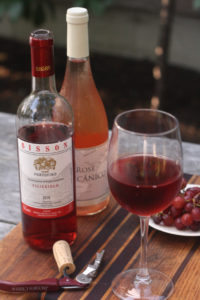
With July behind us and each evening on our glorious peninsula growing shorter, we sense this summer beginning to flit through our grasp. We cherish our last few visitors somehow more than the others who came early on. And I, for one, am done with sharing cheerful but unremarkable wines. Especially the lightly sweet rosés flogged all season long as a tonic for the humidity.
Something more than strawberry flavors and matching pink colors are needed to stir one’s late-season soul. There are dinner-worthy rosés out there, and their time is now.
My gambit this year is to turn to Portugal and Italy for inspiration. First, the breadth of unique expressions of their indigenous varietals is exciting to explore. These are nations that know what they’re doing when it comes to making wine to drink with food.
The confusion that results from unfamiliar grape names, like Ciliegiolo and Agronómica, is a welcome benefit if for some reason you want to prove you’re an adventurer.
Both of those varietals can lead the way to what you’re looking for in a fine dinner rosé, which is a complex flavor profile comparable to a red.
Ciliegiolo (“chili-eh-jolo”) is a red grape indigenous to Liguria, grown atop impossibly steep sloping vineyards perched above the Mediterranean. This grape rarely lands on our shores, because the locals where it grows devour nearly all of it themselves.
That’s a good starting point if you’re trying to improve your wine experiences: look for wines that are beloved in the local communities they come from. That usually means they’re a true expression of a place. And that, we know, is a good thing.
One Ciliegiolo I’ve seen in Outer Cape wine shops is Enoteca Bisson. Grower Pierluigi Lugano began as a trader in small lots of bulk wine and later became a wine merchant and finally a grower in his own right. He fell in love with the wines of the Ligurian coast in 1978 and has worked to preserve both indigenous varietals and their vineyards, which must be worked by hand because of the slopes. Steamed clams, calamari fritti, or a plate of charcuterie, Prosciutto di San Daniele, perhaps, will be meaningfully enhanced by this wine.

From Portugal, Rosé Vulcánico is a remarkable dinner rosé made from grapes grown on the lava field of a volcanic atoll. Saborinho and Agronómica are local varieties found only in the Azores, though they’re blended in this case with Aragonez and Touriga Nacional from the mainland. A lower alcohol level (12 percent), an undertow of persistent acidity, and saline minerality define this wine. It’s one to pair with flavor-packed summer foods; think of it when you grill bluefish or serve tuna poke or if you are making paella or pulled pork tacos.
What these two wines share, though one hails from Liguria and the other from the Azores, is their ability to stand up to the bright, bold flavors of any late summer dinner. I’m thinking grilled swordfish and the perfect lime and garlic aioli. Or maybe cold slices of sirloin steak daubed with Dijonaise and served on summer greens.
They’re wines with great texture and intriguing aromatics. They’re what you want with food. They just happen to be magenta.
Ask your wine seller about full-flavored rosés for drinking with late summer dinners. The basics on the two I’ve described here:
On the Shelf
Enoteca Bisson “Ciliegiolo” Rosé 2018, Golfo del Tigullio, Cinque Terra, Liguria, Italia. Vinified dry, tastes of crisp, dry red cherry and wild berries, and is a brilliant magenta color. 1,700 cases produced; 12 percent alcohol. Approximately $25.
Rosé Vulcanico 2018, Azores, Portugal. Aromas of the sea set this rosé apart from lower-priced options. The familiar soft red berry and perfumed cherry fruit of a mid-weight rosé, plus a lees-enhanced creaminess. 530 cases produced; 12 percent alcohol. Approximately $26.



